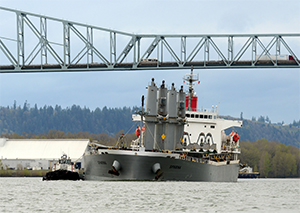The bulk carrier Sparna was outbound on the Columbia River with a load of wheat when it left the navigation channel and struck a charted reef near Wauna, Ore., leaving large rocks lodged inside the hull.
The accident occurred on March 20, 2016, at 2337, just after the 623-foot ship narrowly missed two barges tied to a woodchip dock alongside a mill. A pilot from the Columbia River Pilots was guiding the Panama-flagged vessel, operated by K Line and owned by Santoku Senpaku of Japan, during the voyage. Total damage exceeded $560,000.
The National Transportation Safety Board (NTSB) determined the helmsman did not follow the pilot’s rudder command just before the accident. Rather than move the rudder to starboard 20 degrees as requested, he set it for 20 degrees to port.
In the minutes leading up to the grounding, the NTSB said, “No bridge team member detected the helmsman’s incorrect rudder input or noticed that the Sparna was moving toward the woodchip dock and grounding line.”
The agency cited the failure of the pilot and bridge crew to monitor the helmsman’s response to the pilot’s orders as the probable cause of the accident.
Capt. Rick Gill, president of the Columbia River Pilots, said the ship was executing a difficult turn that required the pilot’s full attention in the moments leading up to the grounding.
“The rudder angle indicator was not visible from the pilot’s conning position, and to monitor the helmsman the pilot would have had to step away from the conning position and divert his attention from the task at hand,” Gill said. “Under those circumstances, the pilot was entitled to expect the ship’s officers would fulfill their duty to monitor the performance of the helmsman.”
Following the accident, the Columbia River Pilots added language to the master/pilot information card provided at the start of each voyage. It now says: “You or one of your officers should monitor the quartermaster at all times to assure that steering commands are being carried out as given.”
The river pilot boarded Sparna at a Portland grain terminal, where the ship loaded wheat bound for Japan. After getting underway at about 1900, the pilot confirmed that bridge crewmembers could speak English in addition to their native Bengali. The master left the bridge about a half hour later and the voyage proceeded normally.
Sparna prepared to meet the 623-foot bulker Yasa Gulten at 2325 near Wauna, Ore. The inbound tanker was in ballast and the two pilots agreed to a starboard-to-starboard passage. According to the report, this is an approved practice in the Columbia River when a loaded outbound ship meets an unloaded inbound vessel.
The Sparna pilot affirmed the passing arrangement in a cellphone call with his counterpart aboard Yasa Gulten at 2332. Sparna’s pilot discussed his ship’s position during the call.
“The VDR recorded the pilot on the Sparna telling the pilot on the Yasa Gulten that he would ‘hold the ship off the barges and stuff’ and that it ‘might look a little strange to you,’ the latter of which he repeated twice,” the report said.
Two minutes after the phone call, at 2334, the Sparna pilot ordered the rudder hard to port. The helmsman complied, placing the rudder at 35 degrees, the standard hard rudder position on the ship. After spotting the rudder angle, the pilot said, “Forty! Forty! Maximum rudder, please! Hard to port means hard to port. It doesn’t mean five or six short.”
Less than a minute later, after another series of rudder commands, the ship was approaching the Georgia-Pacific woodchip dock at about 9.5 knots. The pilot called for “starboard 20” and the helmsman confirmed the order, although the rudder instead moved to port 20 degrees.
The pilot ordered hard to starboard and half-ahead, although the ship’s VDR recorded the rudder moving to port before swinging back to starboard, the report said. Sparna came within 1 meter of a barge tied to the woodchip dock and also narrowly cleared a second barge.
At 2337, the ship struck a rock shelf and its speed abruptly dropped from 8.5 knots to 3.5 knots. The impact tore several large gashes in the hull and the ship later took on water in forward compartments and listed about 3 degrees to port.
The starboard-side forepeak tank had a breach measuring 10 feet long and 5 feet wide, according to the report, and a large rock was stuck inside. The No. 1 port ballast tank had a 25-by-5-foot breach and another measuring 6 feet by 3 inches. Inside the ballast tank was a 3-by-4-foot rock.
The powerful wake that was generated by Sparna’s proximity to the Georgia-Pacific dock caused mooring lines to part on barge No. 34, which was partially loaded with woodchips. Other equipment, including mooring lines and handrails at the dock, also was damaged.
The towboat Western Star was tied up at the dock when Sparna passed. The captain got underway after hearing mooring lines parting and later retrieved the drifting barge, the report said. Western Star also assisted Sparna when it arrived at the anchorage near Cathlamet, Wash., and remained in place until a relief tug arrived.

